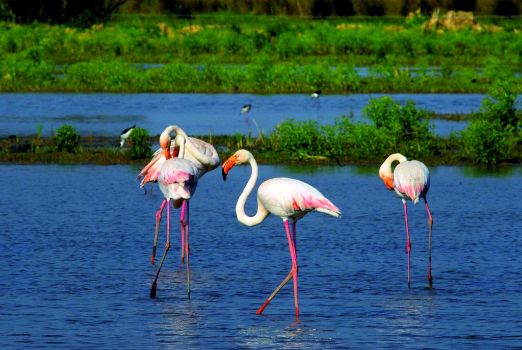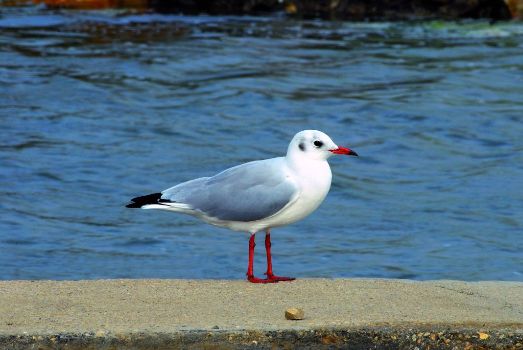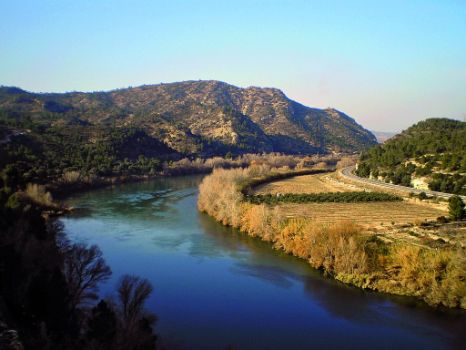Net of Natural
Trails

Stage 38: Flix - Móra d'Ebre
Description
The Pas de l’Ase Gorge
The Flix towboat, one of the two operating in the Catalan section of the Ebro, allows you to jump onto the left bank of the river. You leave behind the Ascó nuclear power station and the Serraneta farmhouse and enter Vinebre and, shortly after that, you return to the right bank of the river on the Ascó bridge. On leaving the village, take the Barbers path to cross the Pas de l’Ase gorge, a sheer drop in the rocky outcrop, and enter the Móra d’Ebre depression after a descent with several zigzags. Skirting the island enclave and the Subarrec oxbow lake, part of the Illes de l’Ebre Protected Natural Area, you will reach the finish line at Móra d’Ebre.

The Flix municipal free boat crossing service allows you to cross the Ebro to reach a recreational area on the other side of the river where you can have a refreshment break. The stage has barely begun, so continue straight on along the paved path that will take the user to a bend where you will take the path on the right, accessing the Pla d’Ini fruit-growing plain.
The path becomes lighter and the descent begins over a small pass, with the image of the Ascó nuclear power station in your mind’s eye. After passing a plain of olive groves and the Mas de Comte, the path joins another track that narrows as it progresses across the hillside. The spectacular cooling tower in the Ascó complex stands on the opposite bank, while the route continues past the gate of the Masía de la Serraneta country house, a fine example of traditional architecture, and moves south, without changing direction, into the village of Vinebre, where you can visit the House-Museum of Enric del Osso and the Iberian settlement of Sant Miquel. To leave the village, once you reach the vicinity of the C-12 road, the trail enters an underpass to negotiate the bridge at Ascó, a village you enter by the Camposines road. Ascó, which traces its origins to an ancient Iberian village that protected the strait of the Pas de l’Ase, preserves an interesting Moorish quarter on the sides of the hill where its castle stands.

You need only head south down the street to reach the Mare de Déu hermitage, before leaving via the C-12B road. After walking 500 m along it, on a bend on the left, leave it and continue along a path that descends, crossing the La Gala gorge: this is the beginning of the Barbers trail.
A route with good views of the Ebro which runs along the railway line on the left. Bypass a first tunnel, under the railway, and cross the second passage that appear, then continue parallel to the railway, this time on the north side. A further left turn precedes another tunnel that is not taken. Not so the fourth, which you should cross. There is then a signpost for local hiking routes and you take the left-hand branch which, after a few metres’ ascent, you will leave and climb a path that will take you through the Pas de l’Ase gorge.

The path follows the rocky outcrop, above the railway and the river, before winding its way dizzyingly up a step carved out of the escarpment. Several zigzags descend and leads to a ledge that acts as a viewpoint, where you can enjoy the information posted on a table explaining the landscape. You will then reach a riverside field after climbing again to the height of the railway, where reeds have colonised the area. Once you have cross, heading southeast, a path begins which, in the first section, hugs very close to the track, but which later opens to the Sènies de García cultivated area. The route leads past the train station and the Mas de les Sènies before reaching a crossroads, where it meets a trail that descends from the right, down the Roians gorge, where the GR 171 signs appear.
The route continues straight on, and after passing under the railway bridge (the GR 171 heads away towards García), you negotiate a new narrowing that leads the trail to the riverbed of the Ebro. Here you will notice an escarpment where the Subarrec paved path begins. The trail leaves the river bank and crosses a strip of orchards; it then hugs close to the slope again, level with the islands of Subarrec.
Little is now left before you reach the Móra d’Ebre river park and its jetty. The riverside promenade tends in the square where the local council stands and, between streets, you can see the urban park, a few metres from the peculiar arched bridge of the capital of the Ribera d’Ebre district, which is dominated by a castle of Islamic origin.
Sites of interest
Puntos de interés
Infrastructure
Municipality
Orography
Hostel
Profile

Highlights
Further information
The Ebro's islands
Scattered throughout the course of the Ebro, from Ascó to Deltebre, there is a series of small islands and oxbow lakes that the river has built and differentiated. These are areas with exuberant riverside vegetation of great natural interest, with herons, kingfishers, a variety of small passerines, etc., and a biodiverse riparian formation in good condition (reed beds, silt beaches, willow groves, poplar groves, etc.). They also serve as a bridging biotope during the journey of migratory birds from the delta’s wetlands towards the interior of the peninsula and vice versa, offering them shelter, rest and food. Some of these islands are also part of the Illes de l’Ebre Pla d’Espais d’Interès Natural (PEIN).





